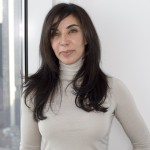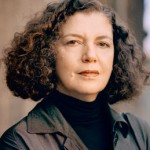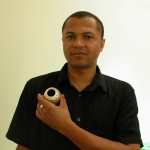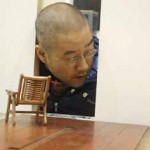 Fariba Alam
Fariba Alam
American/Bangladeshi
B. 1975, Cambridge, Massachusetts; lives and works in Brooklyn, New York
I often find my relationship to my culture and religion to be more spiritual and fantastical than actual in my daily life. A hybrid existence between memory and culture, both a mining of the past and in constant motion, just a step out of sync with the moment.1
After completing a B.A. in Middle East and Asian Languages and Cultures, and specializing in postcolonial theory at Columbia University in 1998, Fariba Alam went on to receive a Fulbright fellowship for photography and a Master’s in Studio Art at New York University. Alam’s works on tile are the culmination of her academic, personal, and cultural background as an American woman of Bangladeshi descent. Each tile is made by hand and involves a process of painting, acetate transfer, and the application of a layer of acrylic before it is fired in the kiln.
Night Journey references the Islamic parable of the same title, also known as “Mir’aj,” where the prophet Mohammed takes a mystical voyage from Mecca to Jerusalem riding a half-angel, half-horse creature. Alam titled her piece after realizing that her longtime interest in the mystical content of Mohammed’s story made its way into her own representation of ascent, travel, and fantasy. Each of the eight identical tiles which make up Night Journey shows a woman facing up toward a dream-like sky, escaping to a fantastic realm or perhaps to a transcendental state of prayer. Alam conveys a fluidity between the tangible and the surreal by placing the woman against a glowing screen of highlighted Arabic texts. Space and direction are rendered ambiguous, as the eight identical tiles are aligned next to each other in such a way that the woman alternately faces up then down. In her serial use of the image, Alam draws upon a device commonly found in both modern art and Islamic design.2
- Statement provided by the artist, January 22, 2010.
- http://www.faribaalam.com, February 6, 2010.
 Zoulikha Bouabdellah
Zoulikha Bouabdellah
French/Algerian
B. 1977, Moscow, Russia; lives and works in Paris, France
I aim to transcend traditional boundaries imposed by society. I place myself at the center of my work: firstly as a woman, and then as a woman who is French, European, Arab, and African from the Maghreb region.1
Video and installation artist Zoulikha Bouabdellah was born in Russia to Algerian parents. She was raised in Algiers, where her mother was the director of the National Museum of Fine Arts. In 1994, her family moved to Paris. There, she studied at the Ecole Nationale Supérieure d’Arts de Cergy-Paris, receiving a Diplôme National Supérieur d’Expression Plastique in 2002. Bouabdellah has had solo shows in Europe, Africa, and North America and has participated in major exhibitions throughout the world. In 2007, her work was featured in the African Pavilion at the 52nd Venice Biennale. Cosmopolitan in her sense of self and in the practice of her art, Bouabdellah resists hierarchies of personal and cultural identity. She seeks to go beyond set boundaries – of time, place, culture, politics, and aesthetics – to provoke enlightened dialogues. Working in a broad range of media, from video and installation to painting, drawing, and photography, she focuses on issues of national and transnational identity, cultural dislocation, and Arab identity, as well as more universal themes of gender and religion.
Dansons (Let’s Dance), Bouabdellah’s best-known work, is a humorous assertion of the hybrid nature of the artist’s French-North African identity. The work shows the mid-section of a woman’s body as she carefully drapes her hips in layers of blue, white, and red fabrics, the tricolor of the French flag. Once all is in place, she begins a belly dance to the beat of La Marseillaise, the French national anthem. Disrupting traditional perceptions of Maghrebi and French identities as mutually exclusive, Bouabdellah provides a space where familiar symbols of French and Arab identity coexist and comingle. Dansons is a celebratory statement of Bouabdellah’s pluralistic identification of belonging to both cultures. As noted by Siobhán Shilton, Bouabdellah “does not articulate her state of ‘inbetweenness’ in terms of alienation or exile or of having to choose one culture over the other;”….rather, she enacts an “optimistic representation” reflecting her acceptance of “the condition of flux and irresolution in which she finds herself.”2
- Zoulikha Bouabdella, from conversation with the artist, January 24, 2009.
- Siobhán Shilton, “Belly Dancing to the Marseillaise: Zoulikha Bouabdellah’s Dansons,” Contemporary French and Francophone Studies, vol. 12, no. 4, October, 2008, 442.
 María Magdalena Campos-Pons
María Magdalena Campos-Pons
Cuban/Nigerian/American
B. 1959, Matanzas, Cuba; lives and works in Boston, Massachusetts
The Caribbean waters, the Atlantic waters, ripples of memories of past, of present, unfolding so fast that future memories are constructed today. There is the smell, the sound, that strange possibility of carrying the entire sonic landscape in one single shell close to your ears. The crashing rhythms of waves crossing from the island shores and back to the other side of continental walls. The Caribbean, that basin of the Atlantic, is more than geography, history, ideologies; it is a deep blue feeling of some space entrapped between my throat and chest.1
María Magdalena Campos-Pons is one of the most prominent Cuban artists working today. Of Nigerian descent, she studied at the Escuela Nacional de Arte and the Instituto Superior de Arte in Havana. She first came to the United States in 1988 as an exchange student at the Massachusetts College of Art and settled permanently in Boston in 1991. Since 1997, she has taught at the School of the Museum of Fine Arts, Boston.
Campos-Pons draws upon the traditions of Yoruba and Afro-Cuban religious ritual in the exploration of the rootedness and rootlessness of her displaced identity. Variously painted, marked, or otherwise adorned, her body is her subject in the creation of performative self-portraits. In the 10-panel Polaroid series Abridor de Caminos, Campos-Pons represents herself as Elegua, the male trickster deity and keeper of the road in Santeria and Yoruba-based Caribbean religions. Each photograph in the ritualized narrative focuses on an isolated part of the artist’s body or objects associated with the deity. The final panel, included in the exhibition, shows the artist’s legs with symbolic scarification marks in red paint and enframed by Elegua’s principal attribute, the hooked walking sticks (garabatos) used by the trickster to open the road.
Esa Palabra Mar and This Word Waiting is one of many works in which water is a metaphor of Afro-Cuban diasporic identity. In this Polaroid diptych, temporal and geographic boundaries collapse. Campos-Pons invokes her ancestral past in Africa, her native Cuba, and her present in the United States, expressing “an experience of detachment, of being here and there, of constantly desiring an elusive condition of peaceful simultaneity.”2
- María Magdalena Campos-Pons, Statement provided by the artist, email, January 12, 2010.
- Lisa D. Freiman, ed., María Magdalena Campos-Pons: Everything Is Separated by Water, New Haven and London, 2007, 53.
 Lalla Essaydi
Lalla Essaydi
Moroccan/American
B. 1956, Marrakesh, Morocco; lives and works in New York, New York
I do not intend my work to be simply a critique of either culture, Arab or Western….Through these images I am able to suggest the complexity of Arab female identity – as I have known it – and the tension between hierarchy and fluidity at the heart of Arab culture…. In these images, the text is partly autobiographical. Here I speak of my thoughts and experiences directly, both as a woman caught somewhere between past and present, as well as between East and West, and also as an artist, exploring the language in which to “speak” from this uncertain space.1
One of a growing number of female artists of the Maghrebi diaspora, Lalla Essaydi was born in Marrakesh and lived in Morocco until the age of 20, when she married and moved to Saudi Arabia. In the early 1990s, she studied at the École des Beaux-Arts in Paris. She subsequently moved to Boston, where she received her B.F.A. in 1999 from Tufts University and her M.F.A. in painting and photography in 2003 from the School of the Museum of Fine Arts, Boston.
Essaydi’s art focuses on conceptions and misconceptions of the identity of Arab women. Challenging and subverting exoticized Western notions, she seeks to change existing perceptions. In Les Femmes du Maroc #19, the subject is posed as a reclining odalisque (female slave in a harem), a favored portrayal of the Arab woman in the Western Orientalist imagination. Characteristic of Essaydi’s work, the figure is situated in a nonspecific place and dressed in a traditional white garment; her skin, clothing, and every other surface in the picture are covered in Arabic calligraphy—actual passages from the artist’s personal journal. Calligraphy, an art form historically associated with male practice, is here applied to the woman’s body with henna, a female adornment. Traditional cultural codes are thus transgressed and redefined.
- Lalla Essaydi, Les Femmes du Maroc, Brooklyn, NY, 2009, 17.
 Gonkar Gyatso
Gonkar Gyatso
Tibetan/British
B. 1961, Lhasa, Tibet; lives and works in London, England
A shambala is where the real and the spiritual meet, and “The Shambala of the Modern Times” is a representation of my own “shambala.” By unifying traditional Tibetan iconography and elements of Western popular culture, I try to create an illustration of where I find myself today.1
Gonkar Gyatso was born in Lhasa, Tibet in 1961. Growing up under Chinese rule, he had little sense of his Tibetan identity, commenting that he was “educated to have a Chinese socialist intellect within a Tibetan body.”2 In 1980, he began his art education at China’s prestigious Central University for Nationalities in Beijing, specializing in traditional Chinese ink-and-brush painting. He returned to Lhasa in 1984 during a period of Tibetan cultural reawakening, and was finally able to visit Tibet’s monasteries and temples, which had reopened.3 While living in Dharamsala, India, in the mid-1990s, Gyatso was invited to continue his studies in London, and he moved there in 1997. A recent participant in the 53rd Venice Biennale (2009), he identifies himself as a “London-based transnational artist.”
The Buddha, a subject first taken up by the artist in 1989, has become his signature motif. The Shambala of the Modern Times is representative of this ongoing fascination with Tibetan art and also incorporates his more recent interest in Western popular culture. Ordered grids and Chinese calligraphy reference a Tibetan technique and aesthetic, while a lush explosion of color and images from Western popular culture surround the divine Buddha. Shambala is a state of “secular enlightenment,” an individual’s achievement of harmony between his or her physical existence and the surrounding existence of others.4 The Shambala of the Modern Times represents Gyatso’s shambala, fusing Tibetan spirituality with quotidian British life. In his most recent work, Gyatso has turned to the medium of sculpture, once again focusing on the historical Buddha as subject. His Untitled, a headless, seated Buddha, is shown for the first time in this exhibition.5
- Gonkar Gyatso, From conversation with the artist, February 1, 2010.
- Donald Dinwiddie, “Gonkar Gyatso: Contours of Identity,” ArtAsiaPacific, 63, 2009, 134.
- Ibid., 133-34.
- Carolyn Rose Gimian, ed., The Collected Works of Chögyam Trungpa, vol. 8, Boston, 2003, 17-19.
- The sculpture is not illustrated because it was not yet cast at the time of publication.
 Mona Hatoum
Mona Hatoum
British/Palestinian
B. 1952, Beirut, Lebanon; lives and works in London, England and Berlin, Germany
The nomadic existence suits me fine, because I do not expect myself to identify completely with any one place. They are all provisional bases from which to operate.1
Acclaimed for her work in video, performance, and installation art, Mona Hatoum is one of the most celebrated artists of the Middle East diaspora. The daughter of Palestinian exiles, she was visiting London in 1975 when civil war broke out in Lebanon. Unable to return home, she remained in England and enrolled in art school. For the most part, she has lived there or in Berlin ever since, although she travels frequently. Widely exhibited, she has had solo shows in Europe, the United States, Canada, and Australia. On the meaning of her art in general, she has said, it is “… about my experience of living in the West as a person from the Third World, about being an outsider, about occupying a marginal position, being excluded, being defined as ‘Other’ or as one of ‘Them’.”2
Measures of Distance, one of the artist’s best known works, addresses exilic identity and the loss, separation, and displacement caused by war. It also poignantly conveys the closeness of the relationship between Hatoum and her mother, distanced by time, place, culture, and war. Throughout the video, the voice of the artist is heard, alternately in Arabic, conversing with her mother, or in English, sadly reading her mother’s letters. On screen, the mother is shown in the privacy of a shower, her naked body veiled by a curtain upon which the texts of her letters, written in Arabic, are superimposed.
- “Mona Hatoum interviewed by Jo Glencross,” in Laura Steward Heon, ed, Mona Hatoum: Domestic Disturbance, North Adams, MA, 2001, 69.
- Quoted in Michael Archer, Guy Brett, Catherine De Zegher, and Mona Hatoum, Mona Hatoum, London 1997, 127.
 Glenn Kaino
Glenn Kaino
Japanese/American
B. 1972, Los Angeles, California; lives and works in Los Angeles, California
Graft is a contradiction….it is a tragic reminder of the pains of acceptance. It is also an attempt to use the visual language of plastic surgery and all its attendant futuristic imagery as a means to plot an abstract and poetic trajectory of representation beyond hybridity. It’s a step towards embracing contradiction and on-the-fly thinking.1
Born and raised in Los Angeles, Japanese-American artist Glenn Kaino is a master conjuror who bewilders audiences with the uncanny,2 truly a product of a city that thrives on spectacle. In this life-sized sculpture, a plastic ostrich takes on the skin of an actual python stitched on by hand. The work is one of three unnatural metamorphoses in the Graft series, which also includes a pig sewn in cowhide and a salmon covered in sharkskin. Graft (Ostrich) is inspired by the popular body-transforming shows such as Fox’s The Swan or FX’s Nip/ Tuck, through which Kaino comments on contemporary society’s proclivity for bodily alterations. Kaino draws on issues of race and identity in the United States, creating works which are open to multiple interpretations. Graft (Ostrich) provides most literally an uneasy metaphor of hybrid identity. The animal dons what is clearly an unnatural skin sewn on with pronounced, visible stitches that call attention to the sometimes painful circumstances of identity. Nevertheless, this union of two animals ultimately creates a stunning hybrid creature.
Kaino’s conceptual and thought-provoking installations have established him as an important artist in American contemporary art. Most recently, the artist’s work was featured in the 2004 Whitney Biennial and a 2006 exhibition of contemporary Asian American Art at Asia Society in New York; he was also the subject of a solo exhibition in 2008 at the Andy Warhol Museum in Pittsburgh, Pennsylvania.
- Artist quoted in Lauri Firstenberg, “Ninjas and Pirates, Revolution and Romanticism,” Art Papers, 2007, vol. 31, no. 2, 40-45.
- Melissa Chiu, Karin Higa and Susette Min., eds., One Way or Another: Asian American Art Now, New Haven, 2006, 77.
 Daniel Kojo Schrade
Daniel Kojo Schrade
German/Ghanaian
B. 1967, Schienen-Konstanz, Germany; lives and works in Amherst, Massachusetts
I am painting from a space in-between.1
The son of a Ghanaian father and a German mother, Daniel Schrade was born and raised in a small German village where his hybrid identity was an ever present mark of difference. Identity issues were to become a central concern of his art. From 1987 to 1993, Schrade studied painting and graphic art in Munich and Cuenca, Spain. In 1993, he received a Master of Arts Diploma from the Academy of Fine Arts in Munich. In the following years, he worked or taught in Oaxaca, Mexico, Kumasi, Ghana, and Gaggenau, Germany, before moving to Amherst, Massachusetts in 2007. Schrade creates works in series using motifs originating from various contexts but linked to questions of identity and cultural roots. Combined with purely gestural, non-representational elements, these motifs – fragments of figures, letters, words, text – become ciphers of identity. As each series progresses, the artist repeats and transforms the motifs that have become his personal iconic archive.
“Afronauts,” the artist explains, “are dis-located characters who create and control their own image spaces, where they claim the power to define themselves and to re-negotiate identity ascriptions.”2 As in Afronauts 08C01, these figures dress in a kind of space suit costume with various head coverings (helmets, hats, caps). The Afronaut character was inspired by Lee “Scratch” Perry, a Jamaican record producer and musician who was known to perform in such a costume. According to Schrade, “the figurative presence of the Afronauts generates disturbances in what is primarily a homogeneous way of painting, and it transforms my [the artist’s] work into what has been called ‘painting from the spaces in between’ (Jochen Meister, Afronauts, Karlsruhe, 2007, 14).”3 Schrade’s Afronaut figures follow in the tradition of the Ghanaian trickster Anansi the Spider and his modern equivalents: Felix the Cat, El Ahrairah, and Wile E. Coyote. Schrade began the Afronauts cycle in 1999; in Afronauts 08C01, the artist makes use of fragments from the word “Afronaut” and an actual Ghanaian wheat sack to particularize the African identity of his two trickster Afronauts.
- Daniel Kojo Schrade, from conversation with the artist, January 28, 2010.
- Statement provided by the artist, July 3, 2009.
- Ibid.
 Zineb Sedira
Zineb Sedira
French/Algerian
B. 1963, Paris, France; lives and works in London, England
This multiple consciousness affords you a particular space when you are negotiating your place in relation to others. It’s a space which is often referred to as “in-between.” I don’t like to see it as a negative place, rather I see it as an active site of exploration that speaks of different histories and locates identity to a place which is endlessly remade through our negotiation of boundaries – this obviously presents challenges to those who are and who are not familiar with this sense of perspective.1
The daughter of Algerian immigrants, French-born, London-based Zineb Sedira has been negotiating boundaries throughout her life. Her personal history resonates with themes of difference, displacement, diaspora, and memory that dominate her art; however, since 2006, the autobiographical content of her work has been subsumed by more universal narratives. Working in video, installation, and photography, Sedira first gained recognition in the late 1990s. Moving from Paris to London in 1986, she studied at Central Saint Martins College of Art and Design (1992-1995), the Slade School of Art (1995-1997), and the Royal College of Art (1998-2003), acquiring an art education richly informed by postcolonial theory. While she settled in England, her parents left France and moved back to Algeria in 1990. After an absence of ten years, Sedira returned to Algeria in 2002, when she first began to photograph and film there. She returns regularly to Algiers, where she maintains an apartment.
MiddleSea, a single screen video installation, is one of three major film projects in Sedira’s recent body of work. As in the other films, Saphir (2006) and Floating Coffins (2009), the sea and boats are the focus of symbolic content. MiddleSea is a visual reflection on the notion of crossing, represented as the journey of a lone male figure aboard a ferry on the Mediterranean between Algeria and France. Enigmatic and eerily enhanced with intermittent sound effects, the film provokes an uneasy, undetermined sense of longing. Aesthetically, it displays a refined sensibility in the way it frames visual elements as compositions of abstract beauty and simplicity. As described by the artist, MiddleSea is “a metaphor for cultural crossovers, languages, translation, and historical memories; a space where new voices, bodies, and histories are encountered; a geo-political area that is a continual interweaving of cultural roots and historical routes; a site of antique civilization and of contemporary tourism and migration.”2
- Zineb Sedira, interview with artist Edith Marie Pasquier, 1997, as quoted in Rachel Garfield, “Zineb Sedira,” 2001, http://wwwsonicgenes.co.uk/zineb/text.html
- Zineb Sedira as quoted in “Zineb Sedira: Floating Coffins, Saphir and MiddleSea, ” exhibition notice, New Art Exchange, February 7 – April 19, 2009, http://www.thenewartexchange.org.uk/exhibitions/ExhibZinebSadera.php
 Shahzia Sikander
Shahzia Sikander
Pakistani/American
B. 1969, Lahore Pakistan; lives and works in New York, New York
I am interested in recorded histories and their paths of evolution in terms of what gets culled and elaborated. What is usually left out is the space imagination fills in. Drawing upon literature, political and national histories, art history, media and language, and lived experience, I find shifting geographical locations compelling. The indisputable concept of plural identity versus the assertion of a monolithic one, the fear of the other, politicized ideas of patriotism, constantly evolving truths and all the bizarre shifts between reality and perception are but some of the elements that provide paradox, humor, irony, and material for me.1
Liberating herself from the confines of established borders, Shahzia Sikander presents in her works a panoply of stylistic and iconographic elements freely drawn from divergent cultures, styles, and historical periods. This practice originated in her years as a student at the National College of Arts in Lahore, Pakistan, where she mastered the demanding skills of miniature painting, an art form then thought to have little contemporary relevance. Crossing artistic boundaries, she mixed stylistic elements and motifs of Mughal and Rajput painting. After moving to the United States in 1992 to study at the Rhode Island School of Design, she expanded upon the multi-layered, cross-cultural references in her art, including the language of Western historical and contemporary imagery. Sikander practices in a variety of media – prints, painting, drawing, installation, video, and performance. The recipient of a 2006 MacArthur “Genius” Award and numerous other prizes, she has achieved widespread critical acclaim with solo shows and the exhibition of her works in major exhibitions in the United States and abroad.
In both Maligned Monsters I and Maligned Monsters II, Sikander pairs a Hindu female figure with a female figure of Western art, specifically a classical Venus Pudica in Maligned Monsters I and the famous Mannerist nude from Bronzino’s Allegory of Love (National Gallery, London) in Maligned Monsters II.2 The titles of these prints refer to the 1977 book by Partha Mitter Much Maligned Monsters: A History of European Reactions to Indian Art, an exposé of the cultural bias of the Western aesthetic perspective as applied to the appreciation of Indian sculpture and architecture in the nineteenth century.
- Shahzia Sikander as quoted in Sikkema Jenkins & Co., “Shahzia Sikander: Stalemate, April 3- May 2, 2009,” Press release, http://www.sikkemajenkinsco.com/shahziasikander_pressrele3.html
- David O’Brien and David Prochaska, Beyond East and West: Seven Transnational Artists, Champaign, Illinois, 2004, 28.
 Do-Ho Suh
Do-Ho Suh
Korean
B. 1962, Seoul, South Korea; lives and works in Seoul, South Korea and New York, New York
I have referred to my interest in transitional spaces many times. It can be a physical movement, or a nonphysical displacement. As I am constantly in transit, from one place to another, from one culture to another, each movement has an impact, and I have become more aware of the in-between spaces that I so frequently occupy. I do not fear not knowing my destination.1
Trained in traditional Oriental painting at Seoul National University, Do-Ho Suh came to the United States in the early 1990s to study painting at the Rhode Island School of Design, later receiving a MFA in sculpture from the Yale University School of Art. Split between New York and Seoul, Suh’s bi-continental lifestyle has influenced the form and content of his art. Frequently using non-traditional materials, his works are personal and nostalgic yet universal in appeal.
In his earliest works, Suh confronts his transnational identity in creatively reconstructed sculptural forms dwelling on the home (often his own), its domestic objects, and its architectural elements. In Doormat: Welcome Back, he displaces an everyday domestic object from its usual location to a formal art space. What appears to be an ordinary doormat is actually something quite unique: its entire surface is comprised of hundreds of identical miniature human figures made from polyurethane rubber. An orderly amber army lines up row after row, each figure with its arms raised, while a group of black Lilliputians spell out the greeting “Welcome Back.” Exhibited in numerous locations, the decontextualized welcome mat suggests an ambiguous return or arrival, yet the exact destination remains a mystery—Where is home? Doormat: Welcome Back illustrates how Suh’s own cosmopolitan perspective has been influenced by his constantly changing geographical locations. Thus, while he does not identify with a single place or culture, Suh nevertheless investigates this sense of belonging. Another aspect of Suh’s Doormat: Welcome Back concerns the dichotomy between individual and collective identity, the latter traditionally conceived in Korean and East Asian cultures as both homogeneous and unified.2
- Artist quoted in Christine Starkman, Your Bright Future: 12 Contemporary Artists from Korea, New Haven, 2009, 167.
- Elaine H. Kim, Conversations on Asian American Art: Fresh Talk, Daring Gaze: Conversations on Asian American Art, Berkeley and Los Angeles, 2003, 151-153.











